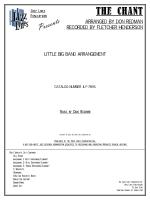CHANT, THE [DOWNLOAD]
Recorded by the Fletcher Henderson Orchestra
Arranged by Don Redman, Transcribed by Dylan Canterbury, Edited by Rob DuBoff and Jeffrey Sultanof

Cat #: JLP-7894DL
$50.00This product is available for immediate download after purchase.
Questions?
Please call +1-518-587-1102 or email us.
Edition: Jazz Little Big Band Arrangement
Description: Swing - Medium
Publisher: Jazz Lines Publications
"The Chant" and "The Henderson Stomp" serve as important documents of the early days of jazz in New York City for multiple reasons. First, they showcase jazz's first great big band, the Fletcher Henderson Orchestra, at their musical peak. Second, they serve as excellent examples of Don Redman beginning to emerge as one of, if not the, first great arrangers in jazz. Third, both pieces are a wonderful collaboration between Henderson and one of the key personalities in jazz at the time: keyboard wizard Fats Waller.
Despite being recorded in 1926, "The Chant" features a number of surprisingly progressive musical choices over the course of its three minute run time. Things kick off with a somewhat mournful figure in the horns before Redman throws out his first surprise - a brief break from Waller playing reed organ (Harmonium). Another unique touch comes immediately after at measure 11 by way of the use of the trombone and tuba as melody instruments, with a plunger muted trumpet solo over the top for added flair. Redman continues to push boundaries by employing a couple of rapid-fire key shifts that begin at measure 20, first from a 4 measure trumpet fanfare followed by 4 measures of some simple syncopation in the woodwinds and piano.
The arrangement settles into the key of Ab for the remainder of the performance at measure 28. Two back to back solo choruses from plunger muted trumpet and banjo commence, with the full band accompanying the trumpet solo but just the rhythm section (with Waller back on organ) behind the banjo. At long last, the main melody occurs at measure 52, carried by trumpet (with no mute) over a simple but mildly harmonically abstract setting in the rest of the ensemble. This melody is followed up by a clarinet trio for a chorus at measure 68, followed by another blues chorus of plunger muted trumpet at measure 84. The ensemble trades some simple figures back and forth between the brass and woodwinds over one more blues chorus at measure 96 before the first few measures of the melody are recycled as an ending.
Woodwind 1: Alto Saxophone/Clarinet
Woodwind 2: Alto Saxophone/Clarinet
Woodwind 3: Tenor Saxophone/Clarinet
3 Trumpets
Trombone
Tuba (or Acoustic Bass)
Banjo (or Guitar)
Organ/Piano
Drum Set
Trombone: E4








